
Official Edgar Rice Burroughs Tribute and Weekly Webzine Site
Since 1996 ~ 10,000 Webpages in Archive
Volume 1412
Presents

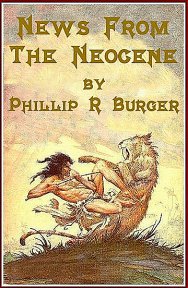 |
Mormons, and Martians: The Possible Origins
|
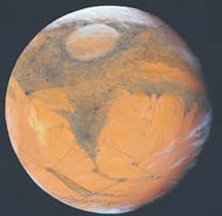 |
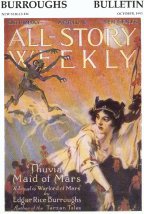
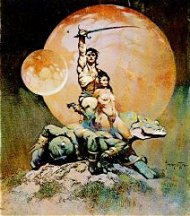
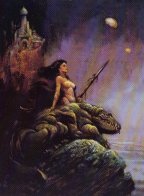
Literary borrowing has been a habit of writers ever since pen was first put to paper -- or papyrus. The test of a good writer is if he can take previously used materials and make something new with them. Edgar Rice Burroughs could do this with great skill and ease. Such borrowing is evident in Burroughs' first book, A Princess of Mars. Not only do the novel's contents suggest this, but as a first-time writer who seems to have done little formal planning before setting down the tale, Burroughs would naturally adapt that which he had read or experienced for his own literary needs.
Richard Lupoff felt that Burroughs was influenced by the fantasies of Edwin Lester Arnold; Fritz Leiber felt that Burroughs was inspired by the Theosophical writings of Helena Blavatsky (1831-1891). And every science fiction history reveals two or three more pre-Burroughs Martian novels so that, if we are to assume that he read and absorbed them all, Burroughs must have been the most well-read individual of the twentieth century. Now to add Burger's Theory to this literary stew: as Burroughs worked out the millennia-long history of Barsoom, he patterned it upon what he knew of Southwestern archaeology and Mormon theology.

Lupoff |
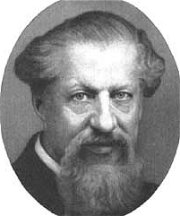
Arnold |
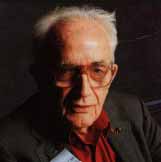
Leiber |
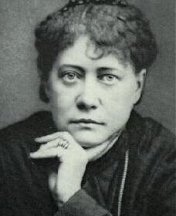
Blavatsky |
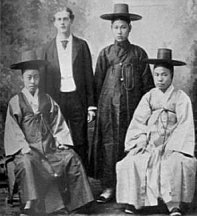
Percival Lowell in Korea |
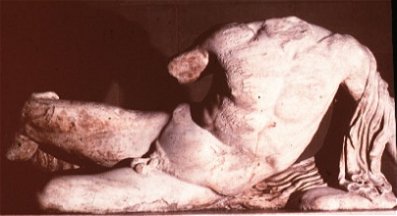
Illisus, a river god of Athens 447-432 B.C. |
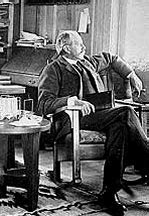
Percival Lowell |
Percival Lowell's popular theories of Martian life have often been attributed as the inspiration for Barsoom, but at best Lowell served as a springboard for Burroughs' imagination rather than a blueprint. Lowell's Mars was old and dried up (as was Burroughs'); Lowell's Martians were capable of great engineering feats (as were Burroughs'); but Lowell felt that any people capable of building a planet-wide canal network would be peaceful and benevolent. This was hardly the setting for an action-adventure series. (This is not meant to discount Lowell's influence, however; for instance, one Martian canal received from Lowell the intriguing name "Illisus.")
Burroughs was a writer with a pack-rat mentality, so odd bits filed away in his mind re-emerged in A Princess of Mars. John Carter's sojourn among the Tharks reads like an exotic Indian captivity narrative (Barsoom itself smacks of the American West.) Red Martian society echoes imperial Rome crossed with the European intrigue of George Barr McCutcheon's "Graustark" novels. And the epochal history that Burroughs outlined for Barsoom -- the drying up of the seas, the blending of the early Martian races, the chipping away of a high civilization by hordes of marauding green men -- has its earthly equivalent in the stories of the "Cliff Dwellers" as well as in the Mormon belief in pre-Columbian migrations and high civilizations in North America.
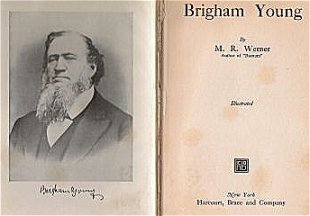
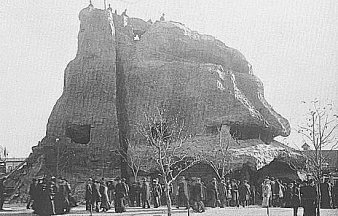
The possibility of such an influence is not as farfetched as it at first sounds. Burroughs could have boned up on archaeology and Mormonism prior to 1911 (he did own a copy of Alfred Vincent Kidder's classic 1924 study An Introduction to the Study of Southwestern Archaeology, which shows a later interest, as well as a biography of Brigham Young), but he may also have had personal experience with both topics. I shall tackle the more incongruous idea first. Burroughs lived for a time in Salt Lake City, had regular contact with Mormon neighbors, and in later years would express his admiration for Mormon settlers and their descendants. Also, Burroughs spent the summer of 1891 punching cattle in Cassia County, Idaho, which had originally been settled by Mormons; if he had been told then of what the Mormons felt had occurred in prehistoric America, of the great migrations and the epic wars, this would have had a strong impact upon an impressionable fifteen-year-old.
The Book of Mormon deals with the possible origins of the North American Indian, as well as potential pre-Columbian New and Old World contacts. The artificial mounds found throughout the Ohio Valley, and the later discovery of Southwestern pueblos and cliff cities, were considered evidence that a people more advanced than the Indian had at one time inhabited the North American continent, perhaps influenced by either the great Central and South American civilizations or some ancient western civilization. The nineteenth century "Moundbuilder" myth pictured a highly developed but indolent race, set upon and overcome by invading barbarians (the Indians); the survivors of this mighty people were either enslaved, assimilated into the victorious tribes, or simply degenerated into savagery. John Wesley Powell made it clear in an 1894 governmental report that the mounds were the result of Indian activity and not some mythical race, but the mindset that created the Moundbuilders, and the theories of social progress that fed it, could not accept the idea of savages building permanent monuments. This thinking can be seen in the many lost race novels of the late nineteenth and early twentieth century.
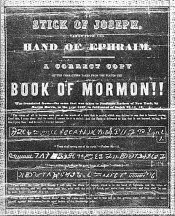 ...
...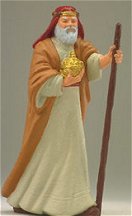 .
. 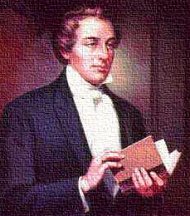
Likewise, The Book of Mormon connects the mounds and other ancient ruins with early Old World contacts; the major migration was that of Lehi and his followers. Ordered by God to flee Jerusalem sometime around 600 B.C.E., the Hebrew prophet Lehi and his band crossed the desert to the sea, built a fleet of ships and set sail for North America. Upon their arrival the Lehites proceeded to set up an urban-centered agricultural-based society. But as with the Biblical account of Noah, there was division among these pioneers. Lehi's sons, Nephi and Laman, argued and parted company, taking with them their respective followers. The Nephites remained civilized while the Lamanites adopted a nomadic, warlike lifestyle. Abandoning their religion and waging perpetual war upon the Nephites, the Lamanites were cursed by God with dark skin. Thus according to Mormon belief, the North American Indians are descendants of the Lamanites and consequently of the House of Israel.
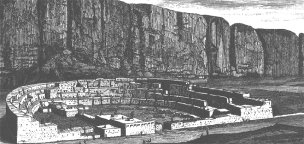
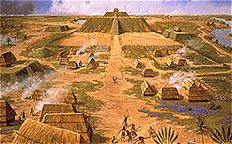
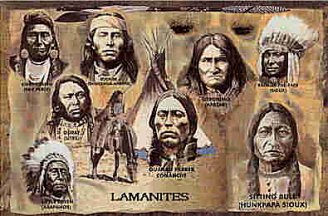
Meanwhile, the Nephites adapt to these changed conditions, building walled cities to protect themselves from attack and continuing their civilized existence. The status quo is maintained for many centuries until the Nephites, grown soft and lazy due to their excessive wealth, let down their guard. The Lamanites seize this opportunity and storm across the Nephite defenses, blotting out this high civilization and leaving only heaps of earth -- the mounds -- as a reminder of the Nephites' existence.
Echoes of this fantastic history can be found throughout Burroughs' equally fantastic Martian series. The Nephites have their Barsoomian equivalents in the Orovars, the dominant fair-skinned race of a million years past, "the most glorious race of human beings a world has ever known," according to the Jeddak of Horz in Llana of Gathol. Burroughs provides a further parallel in Thuvia, Maid of Mars, when the Lotharians describe their ancestors as hating war, "and so we trained not our youth in warlike ways. Thus followed our undoing, for when the seas dried and the green hordes encroached upon us we could do naught but flee." Like the Nephites, the Lotharians became soft due to their peaceful ways, while they "remained in their walled cities wasting their time in play." Once again Burroughs trumpets his long-held belief that through conflict and struggle a nation can remain strong. Others can argue if that is one of the messages of The Book of Mormon.
If this seems to be merely a literary coincidence, then a comparison of Barsoomian history and American archaeology will provide a plethora of coincidences dear to the Burroughs reader.
American archaeology flourished in the late nineteenth century with the discovery in the Southwest of scattered ruins, cliff cities, and elaborate systems of irrigating canals, all of which hinted that at one time the desert states had sufficient moisture to support an advanced civilization. Much written about the "Cliff Dwellers" is spurious, as an overriding concern of many scholars (and the reading public) was to discover an American past that could lay claim to a greater sense of antiquity than anything discovered in Europe. "This craving for antiquity is not confined to the travelling public," wrote Alfred Kidder in 1936, one of the deans of the field. "Archaeologists have it too ... and all of us, I think, have a sneaking sense of disappointment as the pitiless progress of tree ring dating hauls the Cliff Dwellers ... farther and farther away from the cherished B.C.s." But as inaccurate as much of this early archaeology was, it did capture the American public's imagination.
At the turn of the century, writers on this topic were limited by little more than their imaginations. In speculating when man first came to the Southwest, one text somewhat romantically stated that "some would place it as far back in a geological age as the time when this great air continent [desert plateau] was ... surrounded by water, and raised but little above it. At that time the valleys, which are now so wide, were filled with seas which have long since disappeared." The picture emerged of a time when the desert Southwest was naturally moist and fertile. Small groups of people entered the region and settled in the valleys and on the mesas, either colonists from one of the great Southern civilizations, or else nomads who were driven from the north by warlike savages, or both. "Here the great tribes who constituted the primeval races met and blended their civilizations," blared one Arizona newspaper. "The stone axes of the mound builder and the knives of obsidian of the Aztec are found together in our ruins." Europe couldn't boast of a prehistory like this.
Adopting a sedentary lifestyle meant the development of agriculture, and thus these primitive peoples raised themselves above the surrounding tribes. (Nomadic hunters, since they supposedly didn't produce anything, were seen as an inferior breed.) Slowly the climate changed, became drier, and this resulted in the development of a vast irrigating canal system. Burroughs himself may have seen some of these canals while out on patrol with the Seventh Cavalry in Arizona (there were some ruins in the mountains near Fort Grant) and may have speculated about their origin, as another cavalry writer had done: "These canals were of great size and length, branching out in various directions, and evidently had, at some long distant period of time, enabled the people who constructed them to cultivate thousands of acres of land now justly characterized as desert." Thus we have a people living in isolated urban areas, surviving in a harsh land by building an extensive canal network.
But nomadic savages continued to migrate from the north, possibly the ancestors of the Apache or Navajo, and played havoc with the peaceful agriculturalists. They abandoned their cities, building retreats high up in the cliffs. Farming continued but so did the attacks, and eventually these people were either forced to abandon the land or were wiped out in a final conflict. This great mystery intrigued Burroughs, and, with a fine sense of foreshadowing, he placed this enigma before his readers in Swords of Mars, which opens with Burroughs on an Arizona camping trip, searching for traces of this vanished race. "I had been seeking in their ruined cities for the secret of their genesis and the even stranger secret of their extinction. How I wished that those crumbling lava cliffs might speak and tell me of all that they had witnessed since they poured out in a molten stream from the cold and silent cones that dot the mesa land beyond the canyon." As with the first Barsoomian tale, Mars and Arizona are symbolically linked; in this setting Burroughs would again meet John Carter.
There is, of course, no direct evidence that Burroughs adopted Mormon theology and American archaeology for his own fictional needs; as with Lupoff's and Leiber's theories, my speculations are based upon my own knowledge -- not extensive, to be sure -- of the topics in question and my personal impressions of reading Burroughs. Nor am I suggesting that Burroughs was an unimaginative hack who plagiarized without mercy. Like any fiction writer, Burroughs borrowed and adapted that which struck his fancy (for example, writing Jungle Girl immediately upon reading Casey's Four Faces of Siva). We know that Burroughs was an omnivorous reader, particularly of travelogues, anthropology, history and astronomy. And as a young geology instructor at the Michigan Military Academy, Burroughs became acquainted early on with paleontology and archaeology. Seeking for fictional inspiration in non-fiction is not a rarity; it is the norm. Borrowing for the purpose of literary creation does not make Burroughs less unique. I'm rather grateful he could do it so well.
Phillip R. Burger received his bachelor's degree from the University of Oregon and his graduate degree from Utah State University, where he served as the S. George Ellesworth Editorial Fellow on The Western Historical Quarterly.
![]()
![]()

![]()
![]()

![]()
BILL
HILLMAN
Visit
our thousands of other sites at:
BILL
AND SUE-ON HILLMAN ECLECTIC STUDIO
ERB
Text, ERB Images and Tarzan® are ©Edgar Rice Burroughs, Inc.-
All Rights Reserved.
All
Original Work ©1996-2010 by Bill Hillman and/or Contributing Authors/Owners
No
part of this web site may be reproduced without permission from the respective
owners.